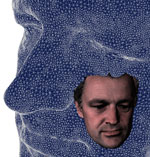




The 2004 EU-Council regulations on standards for security features and biometrics in EU citizens' passport will bring about the introduction of digital facial and fingerprint images in all future European passports. At the same time technical specifications established by the International Civil Aviation Organization (ICAO) will be implemented in the EU member states in order to boost biometrics supported border controls.
While according to the ICAO recommendations, from 2006 biometric-enabled border control will be based on 2D face recognition technology, the drawbacks of this approach are known: The biometric performance of these systems is not satisfactory by far, in particular because it is extremely sensitive to pose variation, illumination changes, sensor condition, and other disturbance factors that might degrade the image quality. Even more serious is the fact that 2D face recognition systems do not currently provide reliable mechanisms for liveness detection and for protection against spoofing and identity hiding attacks. Consequently the reliable usage of this technology in non-supervised environments is still not feasible.

The 3D Face project is clearly focused on 3D face recognition technology research, including fusion with 2D face recognition technologies, and its application in secure environments. The project will follow the approach of exploiting the rich feature space provided by the geometry of the face surface. Not only one order of magnitude performance improvements are expected, but moreover a step towards fake-resistant sensor technology will be taken. The latter is an essential precondition for cost savings and for increased reliability in self-service border controls.
A second focus is on technology research for enabling privacy protection of the 3D biometric templates. Since biometric technologies are widely adopted in multiple applications, the threat of compromising the biometric templates becomes ever more serious. Based on earlier studies it is expected that this research will lead to new technological measures that allows for templates that prevent the possibility for cross-matching and associated data mining, and allows for renewability in case the biometric is compromised.

The technologies developed in 3D Face will be evaluated in a large scale field trial on various European airport sites, in order to test end-to-end performance of the system and to analyze resulting social and operational issues.
The core team of the consortium is already deeply involved in the ISO and CEN standardization work on biometrics. Consequently the project results will directly influence the work program of international standardisation bodies.